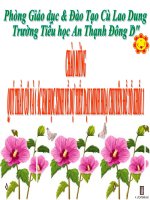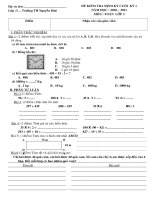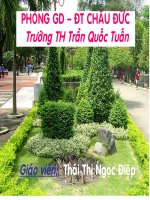Tài liệu học CCNA kỳ 1 mod4 cabletesting
Bạn đang xem bản rút gọn của tài liệu. Xem và tải ngay bản đầy đủ của tài liệu tại đây (544.4 KB, 20 trang )
1
Module 4 – Cable Testing
NIIT-ICT Hanoi 2
Overview
Students completing this module should be able to:
• Differentiate between sine waves and square waves.
• Define and calculate exponents and logarithms.
• Define and calculate decibels.
• Define basic terminology related to time, frequency, and noise.
• Differentiate between digital bandwidth and analog bandwidth.
• Compare and contrast noise levels on various types of cabling.
• Define and describe the affects of attenuation and impedance
mismatch.
• Define crosstalk, near-end crosstalk, far-end crosstalk, and power sum
near-end crosstalk.
• Describe how crosstalk and twisted pairs help reduce noise.
• Describe the ten copper cable tests defined in TIA/EIA-568-B.
• Describe the difference between Category 5 and Category 6 cable.
2
NIIT-ICT Hanoi 3
Background for Studying Frequency
• Differentiate between sine waves and square waves.
• Define and calculate exponents and logarithms.
• Define and calculate decibels.
• Define basic terminology related to time, frequency, and noise.
• Differentiate between digital bandwidth and analog bandwidth.
NIIT-ICT Hanoi 4
Amplitude and Frequency
• A wave is type of energy traveling from one place to another.
• Example: voltage waves in copper wires, light waves in fiber optic cables
electromagnetic waves in wireless communication.
3
NIIT-ICT Hanoi 5
Analog Signal
NIIT-ICT Hanoi 6
Digital Signals
• Square waves, like sine waves, are periodic.
• However, square wave graphs do not continuously vary with time.
• The wave holds one value for some time, and then suddenly changes
to a different value.
• This value is held for some time, and then quickly changes back to the
original value.
• Square waves represent digital signals, or pulses. Like all waves,
square waves can be described in terms of amplitude, period, and
frequency.
4
NIIT-ICT Hanoi 7
Numbering Systems
=
+ = 17 (decimal)
1
×10 + 7×10
1
0
1×2 + 1×2
4
0
+= = 10001 (binary)
1×16 + 1×16
1
0
+= = 11 (hexadecimal)
• Three important number
systems:
– Binary (base 2),
– Decimal (base 10),
– Hexadecimal (base
16).
• Binary system uses 2
symbols: 0,1.
• Decimal system uses
10 symbols:
0,1,2,3,4,5,6,7,8,9.
• Hexadecimal system
uses 16 symbols:
0,1, ,9,A,B,C,D,E,F
• Example: using the
Windows program
CALC to perform
conversion among
number systems
NIIT-ICT Hanoi 8
Exponents and Logarithms
x
y
y = x
0
1
1
y = 10
x
y = log x
10
5
NIIT-ICT Hanoi 9
Decibels
• The decibel (dB) is a measurement unit important in
describing networking signals.
• The decibel is related to the exponents and logarithms
described in prior sections.
• There are two formulas for calculating decibels:
dB = 10 log
10
(P
final
/ P
ref
)
dB = 20 log
10
(V
final
/ V
reference
)
NIIT-ICT Hanoi 10
Decibels
There are two formulas for calculating decibels:
dB = 10 log
10
(P
final
/ P
ref
)
dB = 20 log
10
(V
final
/ V
reference
)
The variables represent the following values:
• dB measures the loss or gain of the power of a wave.
• Decibels are usually negative numbers representing a loss in power as
the wave travels, but can also be positive values representing a gain in
power if the signal is amplified
• log
10
implies that the number in parenthesis will be transformed using
the base 10 logarithm rule
• P
final
is the delivered power measured in Watts
• P
ref
is the original power measured in Watts
• V
final
is the delivered voltage measured in Volts
• V
reference
is the original voltage measured in Volts
6
NIIT-ICT Hanoi 11
Code and Encode
• Information (text, voice, picture, video, ) can be represented
electrically by voltage patterns.
• The data represented by these voltage patterns can be converted to
light waves or radio waves, etc. (signals) to be transmitted over a
media, and then back to voltage waves at the receiver.
• Carrier refers to the signal/waves that carries the information.
• Example: phone system transmitting voice, wireless communication,
Ethernet.
Infomation
is travelling
in digital
signals
Infomation
is travelling
in analog
signals
NIIT-ICT Hanoi 12
Viewing signals in time and frequency
• An oscilloscope is an important electronic device used to view electrical signals
such as voltage waves and pulses.
• The x-axis on the display represents time, and the y-axis represents voltage or
current.
• There are usually two y-axis inputs, so two waves can be observed and
measured at the same time.
• Analyzing signals using an oscilloscope is called time-domain analysis,
because the x-axis or domain of the mathematical function represents time.
• Frequency-domain analysis has the x-axis representing frequency. Spectrum
analyzer is the device that produde such the graph.
7
NIIT-ICT Hanoi 13
Analog and digital signals in time and frequency
• To understand the complexities of networking signals and cable
testing, examine how analog signals vary with time and with frequency.
• Imagine the combination of several sine waves.
a
2
f(x) ∼ F(x) = + [ a . sin (nx) + b . cos (nx) ]
Σ
n = 1
∞
0
nn
NIIT-ICT Hanoi 14
Example
8
NIIT-ICT Hanoi 15
Noise in time and frequency
• Noise is an important concept in communications systems, including
LANS.
• While noise usually refers to undesirable sounds, noise related to
communications refers to undesirable signals.
• Noise can originate from natural and technological sources, and is
added to the data signals in communications systems.
• Even though noise cannot be eliminated, its effects can be minimized if
the sources of the noise are understood.
NIIT-ICT Hanoi 16
Noise in time and frequency
There are many possible sources of noise:
• Nearby cables which carry data signals
• Radio frequency interference (RFI), which is noise from
other signals being transmitted nearby
• Electromagnetic interference (EMI), which is noise from
nearby sources such as motors and lights
9
NIIT-ICT Hanoi 17
Narrowband Interference and White Noice
Narrowband Interference
White Noice
• White noice affects all transmission frequencies.
• Narowband interference only affects small ranges of frequencies.
NIIT-ICT Hanoi 18
Signals and Noise
• Compare and contrast noise levels on various types of cabling.
• Define and describe the affects of attenuation and impedance
mismatch.
• Define crosstalk, near-end crosstalk, far-end crosstalk, and power sum
near-end crosstalk.
• Describe how crosstalk and twisted pairs help reduce noise.
• Describe the ten copper cable tests defined in TIA/EIA-568-B.
• Describe the difference between Category 5 and Category 6 cable.
10
NIIT-ICT Hanoi 19
Signaling over coper and fiber optic cabling
• On copper cable, data signals
are represented by voltage
levels that represent binary
ones and zeros.
• The zero-voltage reference is
called the signal ground.
• If the transmitter and the
receiver volt reference point are
equal, they are said to be
properly grounded.
• Fiber optic cable is used to
transmit data signals by
increasing and decreasing the
intensity of light to represent
binary ones and zeros.
• Optical signals are NOT affected
by electrical noise, and optical
fiber does NOT need to be
grounded.
• As price decrease and speed
increase, optical fiber is more
and more popular.
NIIT-ICT Hanoi 20
Coaxial
• Coaxial cable consists of a
solid copper conductor
surrounded by insulating
material, and then braided
conductive shielding.
• 10Base-2: (thinnet)
Ethernet 10 Mpbs, 185 m,
BNC connector, 50
Ω.
• 10Base-5: (thicknet)
Ethernet 10 Mbps, 500 m,
50
Ω.
11
NIIT-ICT Hanoi 21
STP and ScTP (FTP)
• STP (Shielded Twisted-Pair)
cable contains an outer
conductive shield that is
electrically grounded to
insulate the signals from
external electrical noise. STP
also uses inner foil shields to
protect each wire pair from
noise generated by the other
pairs. Connector: shielded
RJ45, 100m, 150 Ω.
• ScTP (Screened Twisted-
Pair) or FTP (Foiled Twisted-
Pair) is similar with STP, with
exeption that there is no inner
foil shields. Connector:
shielded RJ45, 100m, 100 Ω.
NIIT-ICT Hanoi 22
UTP
• UTP (Unshielded Twisted-
Pair
) has no shield. This is
the most popular cable used
in LAN.
• Connector: RJ45.
• 100 m.
• 100 Ω.
• There are several categories:
Cat-1, Cat-2, Cat-3, Cat-4,
Cat-5, Cat-5e, Cat-6, Cat-7,
12
NIIT-ICT Hanoi 23
Attenuation and insertion loss on copper media
• Attenuation is the decrease in signal amplitude over the
length of a link.
• Long cable lengths and high signal frequencies contribute
to greater signal attenuation.
“good” original signal attenuation
NIIT-ICT Hanoi 24
Impedance
• Impedance is a measurement
of the resistance of the cable
to alternating current (AC)
and is measured in ohms (Ω).
• If the cable is improperly
installed, there may happen
an situation called impedance
discontinuity or impedance
mismatch, which causes
reflection.
• The combination of the effects
of signal attenuation and
impedance discontinuities on
a communications link is
called insertion loss.
“good” original signal reflection
dispersion
jitter
13
NIIT-ICT Hanoi 25
Twisted-pair Cable
• TIA/EIA-568-B certification of a
cable requires testing for a variety
of types of noise.
• In twisted-pair cable, a pair of
wires is used to transmit one
signal. The wire pair is twisted so
that each wire experiences similar
crosstalk.
• Twisting wires also helps to
reduce crosstalk or noise from an
adjacent wire pair. Higher
categories of UTP require more
twists on each wire pair in the
cable to minimize crosstalk at high
transmission frequencies. When
attaching connectors to the ends
of UTP cable, untwisting of wire
pairs must be kept to an absolute
minimum to ensure reliable LAN
communications.
GOOD connector
BAD connector:
wires are untwisted too long
NIIT-ICT Hanoi 26
Cross Talk
• Crosstalk involves the
transmission of signals from
one wire to a nearby wire.
Adjacent wires in the cable act
like antennas, receiving the
transmitted energy.
• Crosstalk is more destructive
at higher transmission
frequencies.
• When crosstalk is caused by a
signal on another cable, it is
called alien crosstalk.
• Cable testing instruments
measure crosstalk by applying
a test signal to one wire pair.
The cable tester then
measures the amplitude of the
unwanted crosstalk signals
induced on the other wire
pairs in the cable.
Twisted-pair cable is designed to take advantage of the
effects of crosstalk in order to minimize noise.
14
NIIT-ICT Hanoi 27
Types of crosstalk
There are three distinct types of crosstalk:
• Near-end Crosstalk (NEXT)
• Far-end Crosstalk (FEXT)
• Power Sum Near-end Crosstalk (PSNEXT)
NIIT-ICT Hanoi 28
Near-end Crosstalk (NEXT)
• Near-end crosstalk (NEXT) is computed as the ratio of
voltage amplitude between the test signal and the crosstalk
signal when measured from the same end of the link.
15
NIIT-ICT Hanoi 29
Far-end Crosstalk (FEXT)
• Due to attenuation, crosstalk occurring further away from
the transmitter creates less noise on a cable than NEXT.
• This is called far-end crosstalk, or FEXT.
• The noise caused by FEXT still travels back to the source,
but it is attenuated as it returns.
• Thus, FEXT is not as significant a problem as NEXT.
NIIT-ICT Hanoi 30
Power Sum Near-end Crosstalk (PSNEXT)
• Power Sum NEXT (PSNEXT) measures the cumulative
effect of NEXT from all wire pairs in the cable.
• PSNEXT is computed for each wire pair based on the
NEXT effects of the other three pairs.
• The combined effect of crosstalk from multiple
simultaneous transmission sources can be very detrimental
to the signal.
16
NIIT-ICT Hanoi 31
Cable testing standards
The ten primary test parameters that must be verified for a
cable link to meet TIA/EIA standards are:
• Wire map
• Insertion loss
• Near-end crosstalk (NEXT)
• Power sum near-end crosstalk (PSNEXT)
• Equal-level far-end crosstalk (ELFEXT)
• Power sum equal-level far-end crosstalk (PSELFEXT)
• Return loss
• Propagation delay
• Cable length
• Delay skew
NIIT-ICT Hanoi 32
Cable testing standards
• The Ethernet standard specifies that each of the pins on an
RJ-45 connector have a particular purpose.
• A NIC transmits signals on pins 1 and 2, and it receives
signals on pins 3 and 6.
• The wires in UTP cable must be connected to the proper
pins at each end of a cable.
17
NIIT-ICT Hanoi 33
Cable testing standards
• The wire map test insures that no open or short circuits
exist on the cable.
• An open circuit occurs if the wire does not attach properly
at the connector.
• A short circuit occurs if two wires are connected to each
other.
NIIT-ICT Hanoi 34
Cable testing standards
• The wire map test also verifies that all eight wires are connected to the
correct pins on both ends of the cable.
• There are several different wiring faults that the wire map test can
detect.
18
NIIT-ICT Hanoi 35
Time-based parameters
• Testers measure the length of the wire based on the
electrical delay as measured by a Time Domain
Reflectometry (TDR) test, not by the physical length of the
cable jacket.
• Since the wires inside the cable are twisted, signals
actually travel farther than the physical length of the cable.
NIIT-ICT Hanoi 36
Testing optical fiber
• Fiber links are subject to the optical equivalent of UTP impedance
discontinuities.
• When light encounters an optical discontinuity, some of the light signal
is reflected back in the opposite direction with only a fraction of the
original light signal continuing down the fiber towards the receiver.
• This results in a reduced amount of light energy arriving at the receiver,
making signal recognition difficult.
• Just as with UTP cable, improperly installed connectors are the main
cause of light reflection and signal strength loss in optical fiber.
19
NIIT-ICT Hanoi 37
Testing optical fiber
• Absence of electrical signals.
• There are no crosstalk problems on fiber optic cable.
• External electromagnetic interference or noise has no affect on fiber
cabling.
• Attenuation does occur on fiber links, but to a lesser extent than on
copper cabling.
NIIT-ICT Hanoi 38
A new standard
• On June 20, 2002, the Category 6 (or Cat 6) addition to the TIA-568
standard was published.
• The official title of the standard is ANSI/TIA/EIA-568-B.2-1.
• Although the Cat 6 tests are essentially the same as those specified by
the Cat 5 standard, Cat 6 cable must pass the tests with higher scores
to be certified.
• Cat6 cable must be capable of carrying frequencies up to 250 MHz and
must have lower levels of crosstalk and return loss.
20
NIIT-ICT Hanoi 39
Summary









